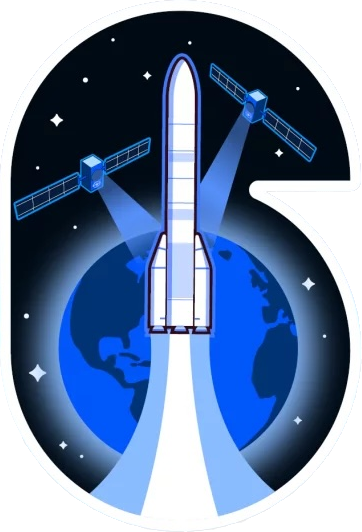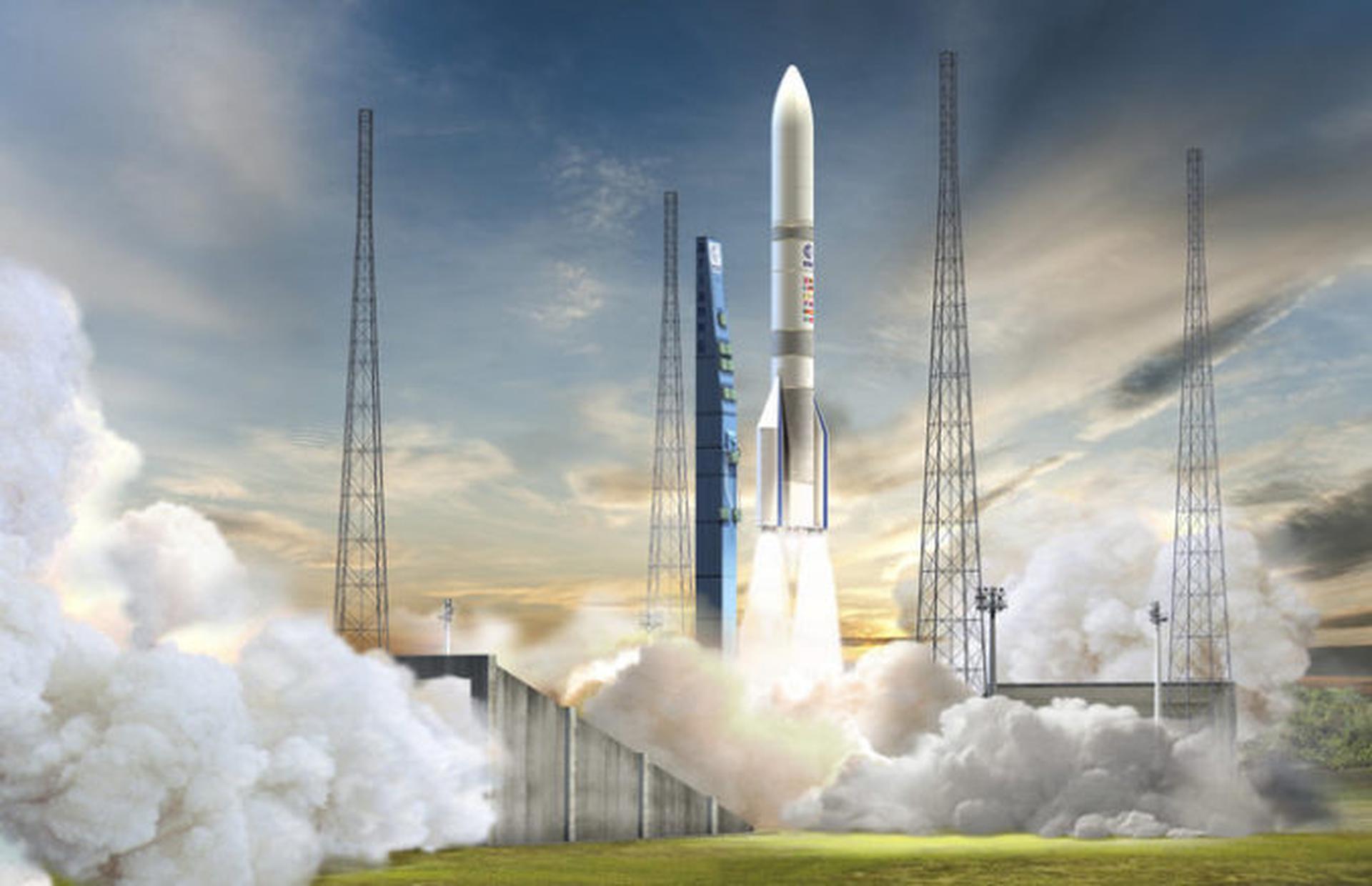Arianespace Launch Schedule
Stay updated on Arianespace's rocket launches with our real-time schedule. You can see 35 planned space missions on our website. Watch the live stream of any Arianespace rocket launch happening today.
Launch Service Provider
Vehicle
Mission
Galileo L14 (FOC FM33 & FM34)
Mission Type
Navigation
Destination
Medium Earth Orbit
Payload consists of two satellites for Europe's Galileo navigation system.
Available Lives
arianespace
arianespace
European Space Agency, ESA
Flight VA266 | Galileo L14 | Ariane 6 | Arianespace
Last Update: Updating Galileo FM numbers, adding launch date and time, and setting GO.
🔔 Set up an email alert for upcoming launches
Get a weekly email containing all launches scheduled for the coming week.
Upcoming Arianespace Launches
TBD
2025
Microcarb is a small satellite designed to map sources and sinks of carbon dioxide (CO2)—the most important greenhouse gas — on a global scale.
Updated: Jan 3, 8:05pm UTC
Sixth South Korean Earth observation satellite of the KOMPSAT series. It is equipped with a synthetic aperture radar with a ground resolution between 0.5 and 20 meters.
Last Update: NET February 2026
TBD
Mar 2026
Amazon Leo, formerly known as Project Kuiper, is a mega constellation of satellites in Low Earth Orbit that will offer broadband internet access, this constellation will be managed by Kuiper Systems LLC, a subsidiary of Amazon. This constellation is planned to be composed of 3,276 satellites. The satellites are projected to be placed in 98 orbital planes in three orbital layers, one at 590 km, 610 km and 630 km altitude. 35-40 satellites will be carried on each Ariane 6 launch.
Last Update: Changed name for batches of Amazon Leo/Project Kuiper satellites to be launched on Ariane 6.
Joint mission between the European Space Agency and the Chinese Academy of Sciences to investigate the interaction between Earth’s protective shield – the magnetosphere – and the supersonic solar wind.
Last Update: NET April 8.
TBD
Jun 2026
Second of EUMETSAT's second generation of Metop weather satellites.
Last Update: NET June 2026.
TBD
Sep 2026
Third of EUMETSAT's third generation of weather satellite.
Updated: Jan 3, 8:05pm UTC
TBD
2026
First dedicated launch for the European Space Agency's IRIDE Earth observation constellation.
Updated: Oct 14, 5:30pm UTC
TBD
2026
Second dedicated launch for the European Space Agency's IRIDE Earth observation constellation.
Updated: Oct 14, 5:30pm UTC
TBD
2026
Optus-11 is a Ku-band communications satellite with a coverage zone encompassing Australia and New Zealand. Optus-11 incorporates a number of advanced technologies, especially the latest developments in digital processing, plus active antennas enabling the creation of several thousand beams.
Updated: Jul 25, 5:00pm UTC
Amazon Leo, formerly known as Project Kuiper, is a mega constellation of satellites in Low Earth Orbit that will offer broadband internet access, this constellation will be managed by Kuiper Systems LLC, a subsidiary of Amazon. This constellation is planned to be composed of 3,276 satellites. The satellites are projected to be placed in 98 orbital planes in three orbital layers, one at 590 km, 610 km and 630 km altitude. 35-40 satellites will be carried on each Ariane 6 launch.
Last Update: NET 2026 with the introduction of Block 2 for Kuiper, per https://spacenews.com/europe-aims-to-end-space-access-crisis-with-ariane-6s-inaugural-launch/
Payload consists of two satellites for Europe's Galileo navigation system.
Last Update: NET late 2026. (37:20 mark)
Amazon Leo, formerly known as Project Kuiper, is a mega constellation of satellites in Low Earth Orbit that will offer broadband internet access, this constellation will be managed by Kuiper Systems LLC, a subsidiary of Amazon. This constellation is planned to be composed of 3,276 satellites. The satellites are projected to be placed in 98 orbital planes in three orbital layers, one at 590 km, 610 km and 630 km altitude. 35-40 satellites will be carried on each Ariane 6 launch.
Updated: Dec 10, 6:30pm UTC
TBD
2026
Plato, for PLAnetary Transits and Oscillations of stars, is a European Space Agency (ESA) mission with 26 cameras to study terrestrial exoplanets in orbits up to the habitable zone of Sun-like stars. Its goal is to measure the sizes of exoplanets and discover exomoons and rings around them, as well as characterise planets' host stars by studying tiny light variations in the starlight it receives.
Last Update: Targeting December 2026
TBD
Mar 2027
Intelsat 45 is a small geostationary communications satellite that will provide Ku-band fixed-satellite services enabling Intelsat to provide specialized and efficient service to Media and Network customers. IS-45 weighs about 1 metric ton at launch and is designed and built by SWISSto12, based on the company’s innovative HummingSat platform. HummingSats are just over one cubic meter in volume, one-tenth the size of conventional satellites placed in geostationary orbit. SWISSto12 is developing the satellites in collaboration with the European Space Agency (ESA) through its public-private-partnership program, benefiting from unique and patented 3D printing technologies.
Last Update: NET early 2027.
TBD
Mar 2027
Payload consists of two satellites for Europe's Galileo navigation system.
Last Update: NET early 2027. (37:20 mark)
TBD
2027
Greek geostationary communications satellite
Updated: Mar 5, 5:01pm UTC
TBD
2028
Two geostationary communications satellites built by Thales Alenia Space for Intelsat.
Last Update: NET 2028.
Atmospheric Remote sensing Infrared Exoplanet Large survey mission (ARIEL) is an ESA telescope. During a 4-year mission, ARIEL will observe 1000 planets orbiting distant stars and make the first large-scale survey of the chemistry of exoplanet atmospheres. For a select number of exoplanets, ARIEL will also perform a deep survey of their cloud systems and study seasonal and daily atmospheric variations. ARIEL shares the ride with another ESA mission, Comet Interceptor. It consists of three spacecraft which will be positioned at the Sun-Earth Lagrange point L2, where they will wait for a long-period comet or an interstellar object to come by. Once the desired target appears, the spacecraft will separate and perform a flyby of the target, compiling a detailed 3D profile of a comet.
Updated: Jan 3, 8:05pm UTC
Payload consists of two satellites for Europe's second generation Galileo navigation system.
Updated: Feb 6, 4:30am UTC
Second of two satellites of Germany's next generation of secure military satellite system. For the Bundeswehr, Airbus is the prime contractor for the design, integration, test and in orbit delivery of two new military GEO telecommunications satellites which are the successor communications satellites to COMSATBw 1 and 2.
Updated: Sep 26, 2:30pm UTC
First of two satellites of Germany's next generation of secure military satellite system. For the Bundeswehr, Airbus is the prime contractor for the design, integration, test and in orbit delivery of two new military GEO telecommunications satellites which are the successor communications satellites to COMSATBw 1 and 2.
Updated: Sep 26, 4:00am UTC



